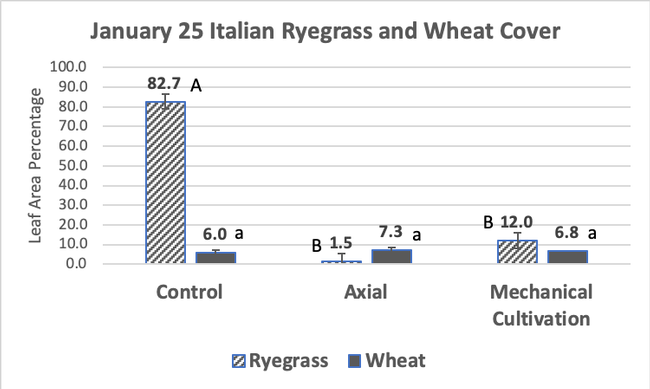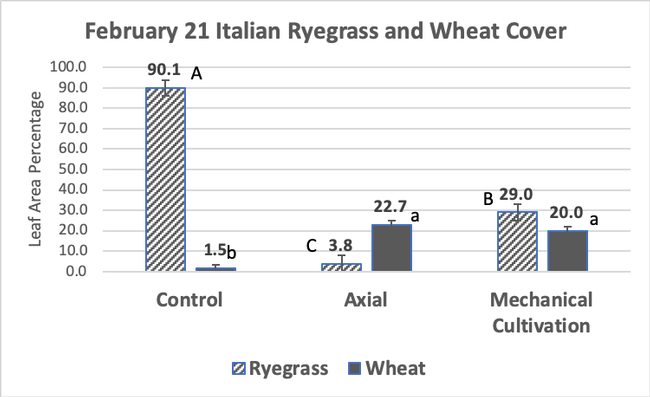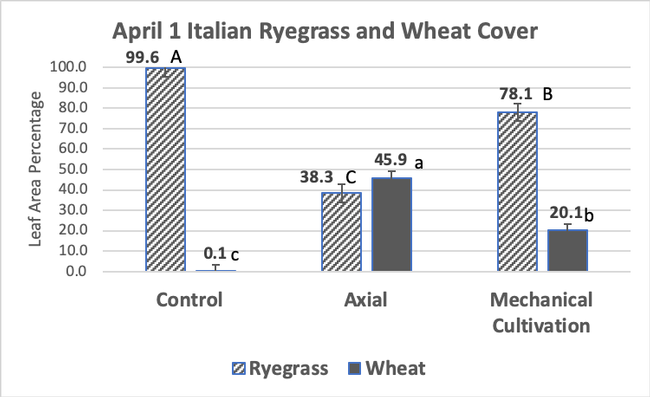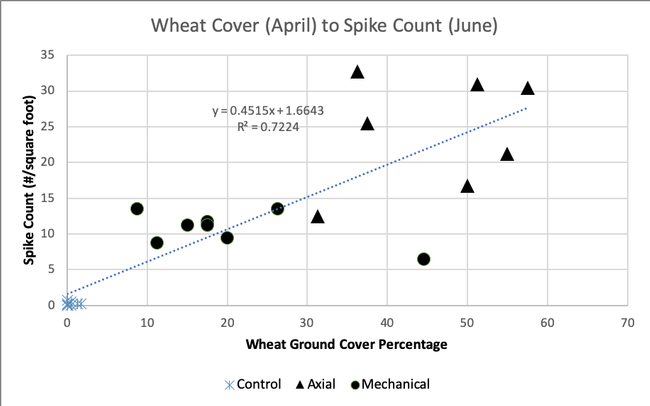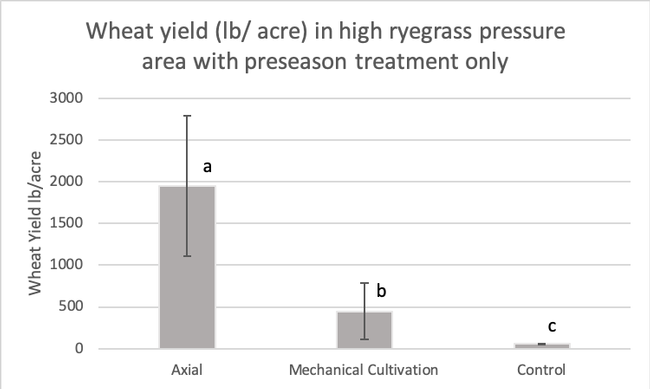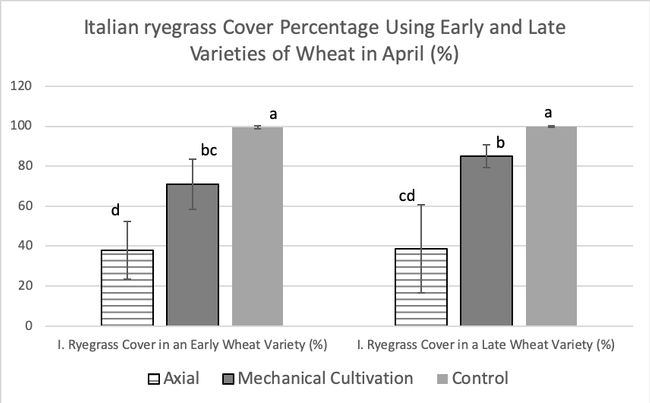Summary Note
Mechanical cultivation is a useful tool in controlling herbicide-resistant Italian ryegrass individuals in a rainfed wheat system but is only about half as effective as Axial in reducing overall pressure from Italian ryegrass (expressed as a percentage of total groundcover). Growers should consider multiple approaches (chemical and mechanical) and integrate IPM strategies to reduce the spread of resistance among Italian ryegrass individuals.
Background
Italian ryegrass (Lolium multiflorum) has been shown to be a persistent weed for growers in rainfed winter grass systems. It is particularly problematic due to its biological requirement for cross-pollination. In outcrossing species, genes can be transferred within and among populations by pollen movement and, as a result, there are many opportunities for gene transfer and accumulation of different traits. Gene transfer can include various herbicide resistance traits and resistance that develops can spread quickly within a field or even to neighboring populations. This is one of the reasons why Italian ryegrass in the Sacramento Valley is widely resistant to glyphosate. Other evidence suggests that Italian ryegrass in certain areas of California has developed resistance to some ALS inhibitor herbicides (Osprey), ACCase inhibitors (e.g. Fusilade), and paraquat, often in addition to being resistant to glyphosate.
Because resistance genes can be passed around relatively quickly in Italian ryegrass, physical (non-chemical) control may help stem the spread of resistant individuals. Additional information on chemical management of herbicide resistance can be found here.
Recent California Research
In the 2019 season we compared the efficacy of mechanical and chemical preseason stale seedbed methods for control of Italian ryegrass in fall-planted wheat trial in Yolo County, CA. Four replicate plots of three treatments were evaluated in a randomized split-plot design. Treatments included a ‘control' (drill-seeding into the prepared seedbed), an ‘Axial' preplant burndown herbicide treatment, and a ‘mechanical cultivation' sequential preplant tillage treatment. In the preplant burndown herbicide treatment Pinoxaden (Axial), an ACCase inhibitor, was applied at the label rate (8.2 oz/ A) 7 days after ryegrass emergence. In the mechanical cultivation treatment, ryegrass was cultivated 7 days after emergence with a 7.5”-spaced, 1.5”-wide-tine field cultivator, and then cultivated a second time 4 days later to ensure complete control of emerged ryegrass. The control treatment was drill-seeded into the seedbed, ryegrass seedlings had already emerged and were roughly a ¼-inch in height. Four replicates of two varieties of wheat (Blanca Grande 515 and Westbred 9433) were planted into the three treatments immediately following the second cultivation (December 14th, 2018). In order to determine the relative effects of pre-season treatments, no in-season herbicide was applied. Percent ground cover of wheat, Italian ryegrass, and bare soil was determined using a 1ft2 quadrat on three occasions throughout the growing season.
Results
Data indicate that Italian ryegrass ground cover was similar among mechanical cultivation and Axial in January (Figure 1). In February, compared with control treatments, mechanical cultivation treatments saw ryegrass ground cover reduced by 68%, Axial reduced ryegrass ground cover by 95%. Despite the significant difference in ryegrass coverage among treatments, wheat ground cover was not significantly different among non-control treatments (20% and 22% for mechanical cultivation and Axial, respectively) (Figure 2).
However, by April, both wheat and ryegrass ground cover percentages were significantly different among all treatments. Compared to the control treatment, the mechanical cultivation treatment had 22% less ryegrass ground cover while Axial reduced ryegrass cover by 62%. Wheat ground cover in the mechanical cultivation treatment was less than half that of the Axial treatment (20% and 47% for mechanical cultivation and Axial, respectively). (Figure 3). The difference in ground cover impacted spike count and yield. Among the three treatments April foliar coverage of wheat was positively correlated with spike count at the end of the year (Figure 4).
Figure 1 Italian ryegrass and wheat ground cover percentages in January (42 days after planting). Significant differences are indicated by different letters. Uppercase letters correspond to differences in Italian ryegrass ground cover among treatments. Lowercase letters correspond to difference in wheat ground cover among treatments.
Figure 2 Italian ryegrass and wheat ground cover percentages in February (69 days after planting). Significant differences are indicated by different letters. Uppercase letters correspond to differences in Italian ryegrass ground cover among treatments. Lowercase letters correspond to difference in wheat ground cover among treatments.
Figure 3 Italian ryegrass and wheat ground cover percentages in April (108 days after planting). Significant differences are indicated by different letters. Uppercase letters correspond to differences in Italian ryegrass ground cover among treatments. Lowercase letters correspond to difference in wheat ground cover among treatments.
Figure 4 Wheat cover as an indicator of spike count. Control plots were largely devoid of any spikes due to substantial Italian ryegrass pressure. Other treatments show a link between ground cover and spike count.
As expected from the ryegrass ground cover data, and the subsequent impact on spike counts, there were significant yield differences among treatments (Figure 5).
Figure 5 Yields resulting from different preseason treatments averaged across two varieties.
Discussion and Conclusion
The difference in ground cover among these treatments is likely due to several factors. One being the fact that cultivation disturbs the soil, bringing new seed up to the surface. Combined with consistent rainfall throughout the winter, a fair amount of new seed may have had an opportunity to sprout and survive in the cultivated treatments. Whereas the herbicide treatment may have terminated individuals that sprouted with the initial rains and, without additional soil disturbance, resulted in recruitment of fewer new seedlings close to the time of wheat seeding and emergence. While later flushes of weeds occurred in the Axial treatment as well, these were either: a) resistant individuals or, b) late-emerging individuals due to differences in dormancy within the seed bank population. What this could mean is that the mechanically cultivated treatment may have had relatively more mature, established, Italian ryegrass individuals, putting the crop at a competitive disadvantage relative to the crop in the Axial treatment.
Cultivation may also have a lower efficacy rate in terminating individuals as some are likely to reestablish despite the disturbance to rootlets. Any escapes would have emerged 11 days before wheat was planted, giving surviving individual ryegrass plants a significant head start over the crop.
In the case of pre-season treatments, mechanical cultivation can provide some relief, but pinoxaden does a better job of mitigating ryegrass pressure.
This study shows that growers can consider the use of mechanical cultivation to remove potentially resistant individuals, but should still consider herbicides to be a part of their pre-season tool kit. As is often cited by IPM specialists, utilizing a wider array of tools to control weeds (both chemical and physical) will help curtail the spread of herbicide resistance and improve grower capacity to maintain economic sustainability.
Additional Data: Variety Effect and the Impact of In-Season Herbicides
An additional factor evaluated in this study was the potential of varieties with shorter and longer ‘days until harvest' ratings to establish a canopy and compete with weeds (referred to here as “early” and “late” varieties). Of the two varieties used in this study (Westbred 9433 and Blanca Grande 515), neither performed significantly better in establishing an early-season canopy relative to Italian ryegrass (Figure 6). As other studies have suggested, differences in wheat variety capability to compete with weeds may be rooted in factors other than the number of days until emergence and other key growth stages, and are instead correlated to other variety traits (plant height, leaf physiology, tillering capacity, etc. Lemerle et al. 1996).
Figure 6 Italian ryegrass ground cover percentage among an early and late variety of wheat and different preseason weed management practices. Letters indicate significant difference between variety x treatment combinations. There was no significant difference between early and late varieties when averaged across treatments.
In-season herbicide treatments play a critical role in reducing weed pressure. In the broader field where this study was conducted, the grower used an in-season mixture of: 7oz Simplicity /A, ¾ pt MCPA / A, 1.5 pt Brox 2E / A. In April, the grower field had 2% ryegrass cover and 98% wheat cover, a substantially more favorable outcome than those seen in the preseason treatments. Therefore, although this study did not directly look at the relative effect of in-season herbicides on Italian ryegrass control, the importance of in-season sprays can be inferred from the condition of the grower field in the surrounding area (and by the notably low yields from the data from this study). Future studies will attempt to clarify the combined effects of in-season herbicides, pre-plant herbicides, and various cultivation techniques to control Italian ryegrass.
